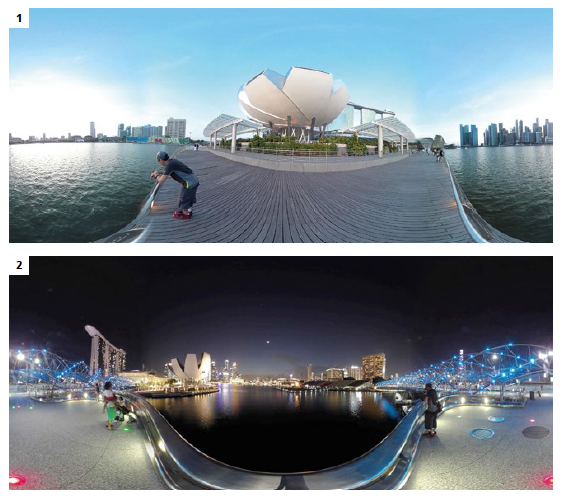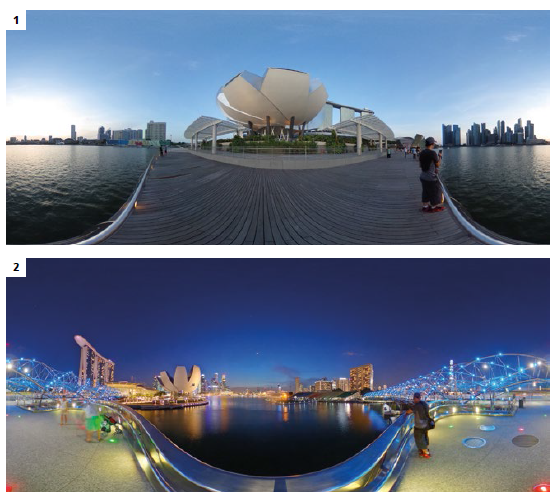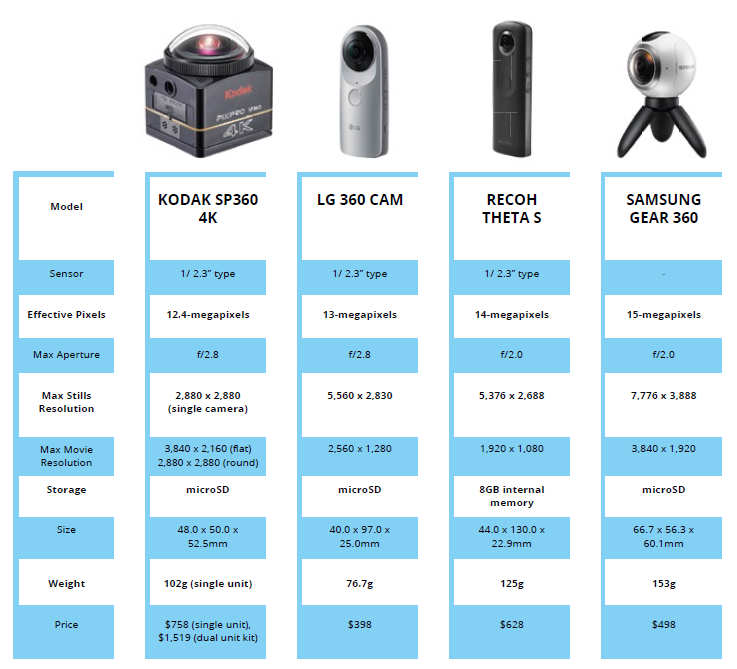Selfies and social media have made sharing your experiences a daily must-do. 360o cameras one-up that, letting you share the entire world around you. We’ve rounded up four of the latest to find out which is best.


Selfies and social media have made sharing your experiences a daily must-do. 360o cameras one-up that, letting you share the entire world around you. We’ve rounded up four of the latest to find out which is best.

KODAK SP360 4K
Kodak has been attempting 360o photography as early as 2014. Their first PixPro SP360 contained a single lens with a 214o field-of-view and did HD (1080p) video, but that didn’t quite hold up to being stretched to the 360o format used by YouTube, so now Kodak has upped their game to provide 4K video with the SP360 4K. The new approach is to use two units mounted back to back, with software to help stitch the resulting captures. Unfortunately this means a larger and more expensive setup overall, as you need two cameras back-to-back, and a mount frame to hold them together. While there is app support for capture via your smartphone, the app is only able to control one unit at a time as each unit creates its own Wi-Fi network to connect to. How you make captures with both cameras simultaneously then, is by way of a remote (included in the DualPro pack) which can be strapped on your wrist like a watch. This has only two switches – to change between shoot modes (stills/video) and capture format (global/front) – and two buttons; one for capture, and one to turn on/off the entire setup. Notifications for a capture or the powering on/off of the unit are by way of beeps and the flashing of the LEDs on both the remote and the cameras. All three units work quite nicely in sync, even powering up and down together. And because 360o photography basically means you’re taking a picture/video of everything around you, you don’t feel like you lose too much without live view from the camera. The Kodak SP360 4K comes with a good deal of accessories right out of the box, especially if you get the DualPro pack, so you won’t have to worry about getting the two units aligned just right. We just wish they used a standard tripod mount as the main connection point instead, as that would have added even more fiexibility to the system.

AT A GLANCE
EFFECTIVE PIXELS: 12.4-megapixels
MAX APERTURE: f/2.8
DIMENSIONS: 48.0 x 50.0 x 52.5mm
WEIGHT: 102g (body only)
PRICE: $1,519 (dual unit kit)


LG 360 CAM
The LG 360 Cam is the smallest and lightest camera in this shootout, and will work with any smartphone as there are versions of the 360 CAM Manager app for both iOS and Android. Unlike the Kodak and the Samsung, the LG 360 Cam comes in a flat stick factor with two spherical cameras on either side, making it easier to transport and hold. Meant to be controlled via app, the camera is very simplistic in design. There are just four tiny LEDs on the body; one to indicate power, one that indicates the camera is in use, and two to indicate shoot modes (360o/180o). Finally, there’s a relatively large shutter button in the center of the body that you can use if you’re not using the app. The camera comes with a dedicated cover that you can flip over to use as a handle extension, and there’s a standard ¼-inch tripod screw thread on its base so you can mount it on any standard photography stand or tripod. Moving on to the 360 CAM Manager app, this follows the standard camera app on most LG smartphones – which means it’s nicely designed, with quite a number of options for manual controls if you so wish. From the app, you can switch between 360o or 180o capture modes, and switch the camera that you’re getting live view from. If you toggle the app to manual mode, you can even adjust things like ISO, white balance and shutter speed in real-time, though you will need to finish recording to go back to automatic mode or to shift between 360o or 180o capture. Overall, it’s a very simple setup, made even better by the fact that the camera automatically processes all the images it takes to a 360o format, so you won’t have to do any processing after you’re done shooting. Simply upload your selected images to a website that supports 360o capture and you’re done.

AT A GLANCE
EFFECTIVE PIXELS: 13.0-megapixels
MAX APERTURE: f/2.8
DIMENSIONS: 40.0 x97.0 x 25.0mm
WEIGHT: 76.7g (body only)
PRICE: $398 (body only)


RICOH THETA S
Like the LG 360 Cam, Ricoh’s Theta S camera also comes in a long stick factor, with a few simple buttons that allow you to trigger the shutter and switch between modes. However, the Theta S is significantly longer, and has LED icons to indicate the connection status and the capture mode it currently is in. It adds a new Wi-Fi module that brings four times the transfer speeds of the previous model, and increases resolution and ISO range while doubling the internal memory. Unlike the other cameras in this shootout, the Theta S has an internal memory of 8GB so you can really pick it up and just start shooting. There’s a standard ¼-inch tripod screw thread on its base for easy mounting, and it comes with a padded cover for transport. The rubber nish over the camera and the longer (130mm) body makes this the easiest camera to hold in your hand though, as there’s enough body for you to grasp without fear of touching the lens. Connecting to the app requires putting your camera on the dedicated Wi-Fi network created by the Theta S, and we found the connection to be fairly stable throughout. You have a choice between panorama or full screen mode, but both have their own issues. The app is locked in portrait view, so even if you tilt your phone, you only get a small panorama across the width of your phone. That leaves for a huge shutter button, and a menu which has two arrows with the mode name in between. Clicking on either arrow cycles between modes (auto, shutter priority, ISO priority, and manual), with various options respective to the mode appearing at below. It’s not the most intuitive design, but is functional enough. Like the LG 360 Cam, images from the Ricoh are stored directly to 360o format so you can upload them without further processing.

AT A GLANCE
EFFECTIVE PIXELS: 14.0-megapixels
MAX APERTURE: f/2.0
DIMENSIONS: 44.0 x 130.0 x 22.9mm
WEIGHT: 125g (body only)
PRICE: $628


SAMSUNG GEAR 360
In terms of physical appearance, the Gear 360 most embodies the idea of a 360o camera, as it resembles a sphere with a flat base that has a standard ¼-inch tripod screw thread. This looks nice, but makes for tricky handling as the tiny tripod legs don’t present you with a good grip. The spherical design also means that you’re bound to get fingerprint marks all over the two fisheye cameras on the camera. There’s a microSD slot, USB port, and battery kept behind a flap on the side of the camera, and a tiny PMOLED display on top to indicate status and which mode the camera is in. As with the other cameras above, live view and control of the Gear 360 is via app. However, at the moment that works only with selected Samsung smartphones so is a bit of a closed system. Also, the camera doesn’t create 360o images on its own, nor is there software you can download to process the images on your computer (the Samsung software only handles 360o video), so you will have to transfer them to one of the newer Samsung Galaxy phones to have them processed. That said, the app interface itself is quite nice. Like the app on the LG, this is nicely laid out, with easy access to settings like White Balance, Image size, Exposure Compensation, and Selftimer. The nice thing is that the app supports landscape orientation, so you can really take advantage of the entire length of the screen. However you don’t get the manual controls available with the apps for the Ricoh and the LG, and it would be better if the mode icon was better demarcated as at the moment it looks more like a label than a button.

AT A GLANCE
EFFECTIVE PIXELS: 15.0-megapixels
MAX APERTURE: f/2.0
DIMENSIONS: 66.7 x 56.3 x 60.1mm
WEIGHT: 153g (body only)
PRICE: $498 (body only)


KODAK SP360 4K
Because it requires a two unit setup, we expected the SP360 4K to produce the best images in low light, and and images taken in low light certainly were a lot cleaner than what we could get with the LG 360 Cam and the Gear 360. But in terms of overall sharpness and handling of noise, fell short of what the Ricoh Theta S produced. The camera also seemed to be prone to flaring; likely because the automatic exposure seems to expose for shadows. Images from the SP360 4K were easily the brightest for every shot. In our outdoor test at the Singapore ArtScience Museum, we had sunset in front of us, and the museum behind. With the LG and the Samsung, this produced an obvious band where the images from front lens and rear lens met, but with the SP360 4K this was decently controlled.

LG 360 CAM
Images taken with the LG 360 Cam look good straight out of camera, and its exposure system tends to give a more accurate reflection of the scene compared to the Kodak SP360 4K. However, we found that noise tends to seep into to your images significantly once light levels drop. In our shots from the helix bridge, there’s so much noise that you can barely make out any of the lines in the picture. Color noise is abundant too; something that’s very evident in the image of the ArtScience Museum. As we noted above, there’s also quite an obvious band where the image from the front lens blends with the one from the rear lens. If there’s a person/object at that spot, you’ll likely find severe blurring there too, indicating that the algorithm for blending images in-camera could do with a bit of fine-tuning.

RICOH THETA S
In terms of sheer image quality, the Theta S stands out as the best among the group. Images from this camera hold good detail, and the camera gives you great low-light performance as evidenced from the shot on the Helix bridge. There’s a nice rendering to the night sky, and compared to the other cameras, flaring from bright light sources is fairly well controlled. There really isn’t much color noise in any of the images from the camera, though some smudging from noise reduction does occur in overcast situations. What’s most impressive though, is how well the blending between the front and rear lens is handled. In most of the images captured, the only give away is a slight bit of smudging. You don’t get a huge diff erence in exposure between front and rear cameras, and the only give-away is when you pan straight up.

SAMSUNG GEAR 360
Handling concerns aside, taking images with the Gear 360 is quite a pleasant experience thanks to the nicely designed app, and the fact the camera itself is fairly responsive. Like the LG 360 Cam, images from the Gear 360 are nicely exposed, and have good colors. However, it too suffers in low light, as the combination of abundant noise and over-aggressive noise reduction makes for pictures with little detail but plenty of artefacts. Also, the joins between images from both lenses are quite obvious compared to the rest of the cameras in this shootout; especially when you look at the image of the ArtScience Museum where there’s an obvious line down the boundary where the images from both lenses meet. Flaring is fairly well-controlled, but we do think the camera could do a better job with fine detail given it has the sensor with the highest rated resolution.
























